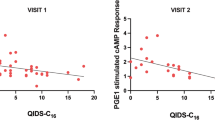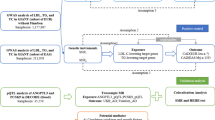Abstract
In contrast to healthy controls, the heterotrimeric G protein, Gsalpha (Gsα) is ensconced predominantly in lipid rafts in subjects with major depressive disorder (MDD) resulting in impaired stimulation of adenylyl cyclase. In this small proof-of-concept study, we examined the hypothesis that translocation of Gsα from lipid rafts toward a more facile activation of adenylyl cyclase is a biomarker for clinical response to antidepressants. There were 49 subjects with MDD (HamD17 score ≥15) and 59 healthy controls at the screen visit. The AlphaScreen (PerkinElmer) assay measured both basal activity and prostaglandin E1 (PGE1) stimulation of Gsα-adenylyl cyclase to assess the extent of coupling of Gsα with adenylyl cyclase. At screen, platelet samples obtained from MDD subjects revealed significantly lower PGE1 activation of adenylyl cyclase activity than controls (p = 0.02). Subsequently, 19 consenting MDD subjects completed a 6-week open label antidepressant treatment trial. The 11 antidepressant responders (HamD17 improvement ≥50% from screen) revealed significant increase in PGE1-stimulated adenylyl cyclase compared to non-responders (p = 0.05) with an effect size of 0.83 for the PGE1/Gsα lipid-raft biomarker. PGE1 stimulation increased by ≥30% from screen assessment in eight responders (72.7%) and two non-responders (25.0%) [Fisher exact = 0.07] with a positive predictive value for response of 80.0%. In this small, pilot study, increased PGE1 stimulated adenylyl cyclase was associated with antidepressant response in MDD subjects. These data suggest that a simple, high-throughput-capable assay for depression and antidepressant response can be developed. Future studies are needed to evaluate the utility of this biomarker for the treatment of MDD.
This is a preview of subscription content, access via your institution
Access options
Subscribe to this journal
Receive 12 print issues and online access
$259.00 per year
only $21.58 per issue
Buy this article
- Purchase on SpringerLink
- Instant access to full article PDF
Prices may be subject to local taxes which are calculated during checkout




Similar content being viewed by others
References
Malhi GS, Mann JJ. Depression. Lancet. 2018;392:2299–312.
Liu Q, He H, Yang J, Feng X, Zhao F, Lyu J. Changes in the global burden of depression from 1990 to 2017: findings from the Global Burden of Disease study. J Psychiatr Res. 2020;126:134–40.
Greenberg PE, Fournier AA, Sisitsky T, Simes M, Berman R, Koenigsberg S, et al. The economic burden of adults with major depressive disorder in the United States (2010 and 2018). PharmacoEconomics. 2021;39:653–65.
Huang C, Huang L, Wang Y, Li X, Ren L, Gu X, et al. 6-month consequences of COVID-19 in patients discharged from hospital: a cohort study. Lancet 2021;397:220–32.
Trivedi MH, Rush AJ, Wisniewski SR, Nierenberg AA, Warden D, Ritz L, et al. Evaluation of outcomes with citalopram for depression using measurement-based care in STAR*D: implications for clinical practice. Am J Psychiatry. 2006;163:28–40.
Malberg JE, Blendy JA. Antidepressant action: to the nucleus and beyond. Trends Pharm Sci. 2005;26:631–8.
Fujita M, Richards EM, Niciu MJ, Ionescu DF, Zoghbi SS, Hong J, et al. cAMP signaling in brain is decreased in unmedicated depressed patients and increased by treatment with a selective serotonin reuptake inhibitor. Mol Psychiatry. 2017;22:754–9.
O’Donnell JM, Zhang HT. Antidepressant effects of inhibitors of cAMP phosphodiesterase (PDE4). Trends Pharm Sci. 2004;25:158–63.
Racagni G, Popoli M. Cellular and molecular mechanisms in the long-term action of antidepressants. Dialogues Clin Neurosci. 2008;10:385–400.
El-Haggar SM, Eissa MA, Mostafa TM, El-Attar KS, Abdallah MS. The phosphodiesterase inhibitor pentoxifylline as a novel adjunct to antidepressants in major depressive disorder patients: a proof- of-concept, randomized, double-blind, placebo-controlled trial. Psychother Psychosom. 2018;87:331–9.
Blendy JA. The role of CREB in depression and antidepressant treatment. Biol Psychiatry. 2006;59:1144–50.
Rafa–Zabłocka K, Kreiner G, Bagińska M, Kuśmierczyk J, Parlato R, Nalepa I. Transgenic mice lacking CREB and CREM in noradrenergic and serotonergic neurons respond differently to common antidepressants on tail suspension test. Sci Rep. 2017;7:13515.
Björkholm C, Monteggia LM. BDNF—a key transducer of antidepressant effects. Neuropharmacology. 2016;102:72–79.
Hwang JP, Tsai SJ, Hong CJ, Yang CH, Lirng JF, Yang YM. The Val66Met polymorphism of the brain- derived neurotrophic-factor gene is associated with geriatric depression. Neurobiol Aging. 2006;27:1834–7.
Verhagen M, van der Meij A, van Deurzen P, Janzing JGE, Arias-Vásquez A, Buitelaar JK, et al. Meta-analysis of the BDNF Val66Met polymorphism in major depressive disorder: effects of gender and ethnicity. Mol Psychiatry. 2010;15:260–71.
Li S, Okamoto T, Chun M, Sarguacini M, Casanova JE, Hansen SH, et al. Evidence for a regulated interaction between heterotrimeric G proteins and caveolin. J Biol Chem. 1995;270:15693–701.
Allen JA, Halverson-Tamboli R, Rasenick MM. Lipid raft microdomains and neurotransmitter signaling. Nat Rev Neurosci. 2007;8:128–40.
Bhatnagar A, Sheffler DJ, Kroeze WK, Compton-Toth B, Roth BL. Caveolin-1 interacts with 5- HT2A serotonin receptors and profoundly modulates the signaling of selected Galphaq-coupled protein receptors. J Biol Chem. 2004;279:34614–23.
Allen JA, Yu JZ, Donati RJ, Rasenick MM. Beta-adrenergic receptor stimulation promotes g{alpha}s internalization through lipid rafts: a study in living cells. Mol Pharm. 2005;67:1493–504.
Allen JA, Yu J-Z, Dave RH, Bhatnagar J, Roth BL, Rasenick MM. Caveolin-1 and lipid microdomains regulate Gs trafficking and attenuate Gs/adenylyl cyclase signaling. Mol Pharmacol. 2009;76:1082–108.
Rimon G, Hanski E, Braun S, Levitzki A. Mode of coupling between hormone receptors and adenylate cyclase elucidated by modulation of membrane fluidity. Nature. 1978;276:394–6.
Rasenick MM, Stein P, Bitensky M. The regulatory subunit of adenylate cyclase interacts with cytoskeletal components. Nature. 1981;294:560–2.
Donati RJ, Rasenick MM. Chronic antidepressant treatment prevents accumulation of gsalpha in cholesterol-rich, cytoskeletal-associated, plasma membrane domains (Lipid Rafts). Neuropsychopharmacology. 2005;30:1238–45.
Zhang L, Rasenick MM. Chronic treatment with escitalopram but not R-citalopram translocates Galpha s from lipid raft domains and potentiates adenylyl cyclase: a 5-hydroxytryptamine transporter-independent action of this antidepressant compound. J Pharm Exp Ther. 2010;332:977–84.
Czysz AH, Schappi J, Rasenick MM. Lateral diffusion of Gas in the plasma membrane is decreased after chronic but not acute antidepressant treatment: Role of lipid raft and non-raft membrane microdomains. Neuropsychopharmacology. 2015;40:766–73.
Singh H, Wray N, Schappi J, Rasenick MM. Disruption of lipid-raft localized Gαs/tubulin complexes by antidepressants: a common feature of HDAC6 inhibitors, SSRI and tTricyclic compounds. Neuropsychopharmacology. 2018;43:1481–91.
Liu JJ, Hezghia A, Shaikh SR, Cenido JF, Stark RE, Mann JJ, et al. Regulation of monoamine transporters and receptors by lipid microdomains: implications for depression. Neuropsychopharmacology. 2018;43:2165–79.
Kapoor R, Peyear TA, Koeppe RE 2nd, Andersen OS. Antidepressants are modifiers of lipid bilayer properties. J Gen Physiol. 2019;151:342–56.
Donati RJ, Dwivedi Y, Roberts RC, Conley RR, Pandey GN, Rasenick MM. Post-mortem brain tissue of depressed suicides reveals increased Gs localization in lipid raft domains where it is less likely to activate adenylyl cyclase. J Neurosci. 2008;28:3042–50.
Singh H, Chmura J, Bhaumik R, Pandey GN, Rasenick MM. Membrane-associated α-tubulin is less acetylated in postmortem prefrontal cortex from depressed subjects relative to controls: cytoskeletal dynamics, HDAC6 and depression. J Neurosci. 2020;40:4033–41. May 13.
Pandey GN, Sudershan P, Davis JM. Beta adrenergic receptor function in depression and the effect of antidepressant drugs. Acta Pharm Toxicol. 1985;56(Suppl 1):S66–S79.
Mooney JJ, Schatzberg AF, Cole JO, Kizuka PP, Salomon M, Lerbinger J, et al. Rapid antidepressant response to alprazolam in depressed patients with high catecholamine output and heterologous desensitization of platelet adenylate cyclase. Biol Psychiatry. 1988;23:543–59.
Hines LM, Tabakoff B.WHO/ISBRA Study on State and Trait Markers of Alcohol Use and Dependence Investigators Platelet adenylyl cyclase activity: a biological marker for major depression and recent drug use. Biol Psychiatry. 2005;58:955–62.
First MB, Spitzer RL, Gibbon M, Williams JBW. Structured Clinical Interview for DSM-IV Axis I Disorders-Patient Edition (SCID-I/P, Version 2.0). Biometrics Research Department, New York State Psychiatric Institute, New York. 1995.
American Psychiatric Association. Diagnostic and statistical manual of mental disorders, 4th edition (DSM-IV). Washington DC. 1994.
American Psychiatric Association. Diagnostic and statistical manual of mental disorders, 5th edition. Arlington VA: American Psychiatric Press. 2013.
Hamilton M. A new depression scale designed to be sensitive to change. Br J Psychiatry. 1960;134:382–9.
Posner K, Brown GK, Stanley B, Brent DA, Yershova KV, Oquendo MA, et al. The Columbia-Suicide Severity Rating Scale: initial validity and internal consistency findings from three multisite studies with adolescents and adults. Am J Psychiatry. 2011;168:1266–77.
Rush AJ, Giles DE, Schlesser MA, Fulton CL, Weissenburger J, Burns C. The Inventory for Depressive Symptomatology (IDS): preliminary findings. Psychiatry Res. 1986;18:65–87.
Hamilton M. The assessment of anxiety states by rating. Br J Med Psychol. 1959;32:50–55.
Guy W. Early Clinical Drug Evaluation (ECDEU) assessment manual for psychopharmacology. Publication No. 76-338. Rockville, Md: National Institute of Mental Health. 1976.
Montgomery S, Asberg M. A new depression scale designed to be sensitive to change. Br J Psychiatry. 1979;134:382–9.
Bech P. Rating scales in depression: limitations and pitfalls. Dialogues Clin Neurosci. 2006;8:207–15.
Senese NB, Rasenick MM. Antidepressants produce persistent Gαs-associated signaling changes in lipid rafts after drug withdrawal. Mol Pharm. 2021;100:66–81.
Chukaew P, Leow A, Saengsawang W, Rasenick MM. Potential depression and antidepressant-response biomarkers in human lymphoblast cell lines from treatment-responsive and treatment-resistant subjects: roles of SSRIs and omega-3 polyunsaturated fatty acids. Mol Psychiatry. 2021;26:2402–14.
Caruncho HJ, Rivera-Baltanas T, Romay-Tallon R, Kalynchuk LE, Olivares JM. Patterns of membrane protein clustering in peripheral lymphocytes as predictors of therapeutic outcomes in major depressive disorder. Front Pharm. 2019;10:19047.
Wray N, Schappi JM, Singh H, Senese NB, Rasenick MM. NMDA receptor-independent, cAMP- dependent antidepressant actions of ketamine. Mol Psychiatry. 2019;24:1833–43.
Eisensamer B, Uhr M, Meyr S, Gimpl G, Deiml T, Rammes G, et al. Antidepressants and antipsychotic drugs colocalize with 5-HT3 receptors in raft-like domains. J Neurosci. 2005;25:10198–206.
Erb SJ, Schappi JM, Rasenick MM. Antidepressants accumulate in lipid rafts independent of monoamine transporters to modulate redistribution of the G protein, Gαs. J Biol Chem. 2016;291:19725–33.
Casarotto PC, Girych M, Fred SM, Kovaleva V, Moliner R, Enkavi G, et al. Antidepressant drugs act by directly binding to TRKB neurotrophin receptors. Cell. 2021;184:1299–313.
Dodd S, White IA, Williamson P. Nonadherence to treatment protocol in published randomised controlled trials: a review. Trials. 2012;13:84.
Targum SD, Sauder C, Evans M, Saber JN, Harvey PD. Ecological momentary assessment as a measurement tool in depression trials. J Psychiatr Res. 2021;136:256–64.
Acknowledgements
This research was supported by R43MH097370 and R41MH113398 to Pax Neuroscience and VA Merit BX00149 (MMR). MMR is a VA Research Career Scientist BX004475.
Author information
Authors and Affiliations
Contributions
MMR and MHR designed original study. AK and JS collected data. RB, NR, and SDT did statistical analysis. SDT, JS, NR, MHR, and MMR interpreted data. SDT, NR, MHR, JS, and MMR wrote the paper.
Corresponding authors
Ethics declarations
Competing interests
Dr. Targum is an employee of Signant Health and has received vendor grants and/or consulting fees from Acadia Pharmaceuticals Inc., Alkermes Inc., BioXcel Therapeutics Inc., Denovo Biopharma, EMA Wellness LLC, Epiodyne, Frequency Therapeutics, Functional Neuromodulation, Intra Cellular Therapies, Johnson and Johnson PRD, Karuna Therapeutics, Merck Inc., Methylation Sciences Inc., Navitor Pharmaceuticals Inc., and Sunovion Inc. during the past 3 years. Drs Schappi, Bhaumik, Rapaport and Rasgon, and Ms. Koutsouris report no conflicts of interest. Dr. Rasenick is co-founder and chief scientific officer of Pax Neuroscience. In the past three years he has consulted for Otsuka, Inc and has received research support from Lundbeck SA. He is also supported by grants from the Veterans Administration and is a research career scientist of the VA.
Additional information
Publisher’s note Springer Nature remains neutral with regard to jurisdictional claims in published maps and institutional affiliations.
Rights and permissions
About this article
Cite this article
Targum, S.D., Schappi, J., Koutsouris, A. et al. A novel peripheral biomarker for depression and antidepressant response. Mol Psychiatry 27, 1640–1646 (2022). https://doi.org/10.1038/s41380-021-01399-1
Received:
Revised:
Accepted:
Published:
Issue date:
DOI: https://doi.org/10.1038/s41380-021-01399-1
This article is cited by
-
A simple platelet biomarker is associated with symptom severity in major depressive disorder
Molecular Psychiatry (2025)
-
Rafting toward a depression biomarker
European Archives of Psychiatry and Clinical Neuroscience (2025)
-
Shared and unique transcriptomic signatures of antidepressant and probiotics action in the mammalian brain
Molecular Psychiatry (2024)
-
FMOD Alleviates Depression-Like Behaviors by Targeting the PI3K/AKT/mTOR Signaling After Traumatic Brain Injury
NeuroMolecular Medicine (2024)
-
A novel set of volatile urinary biomarkers for late-life major depressive and anxiety disorders upon the progression of frailty: a pilot study
Discover Mental Health (2022)



